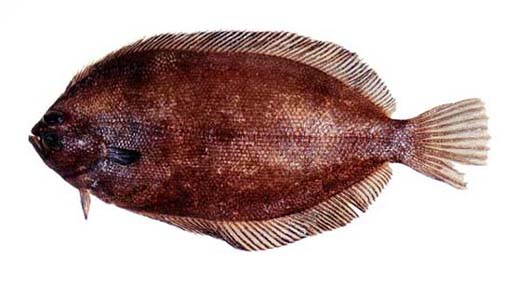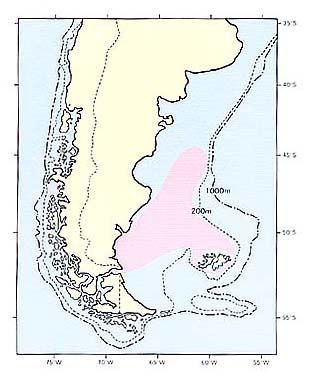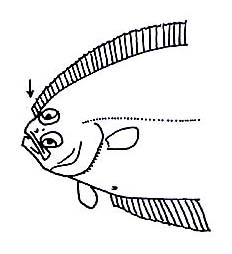ダルマガレイ科
- HOME
- デジタル図鑑
- パタゴニア海域の重要水族
- 硬骨魚綱 カレイ目
- ダルマガレイ科
ダルマガレイ科(Bothidae)

125 マダラヒラメ(Madara-hirame)
Thysanopsetta naresi Günther, 1880
Lenguado (Arg.)
特 徴:
背鰭86軟条,臀鰭63軟条,胸鰭(有眼側)9軟条,腹鰭(有,無眼側)6軟条,尾鰭15軟条,側線鱗数70,下枝鰓耙数21,体長に対する体高の割合は45.0%,頭長は20.7%,眼径は5.8%(上眼),4.8%(下眼),両眼間隔は2.0%,吻長は4.4%,上顎長は8.9%(有眼側),8.3%(無眼側),尾柄高は11.7%,胸鰭長は16.0%(有眼側)。体は長楕円形で,頭部背縁は眼の前縁でややくぼむ。両眼は左位で,両眼間隔域は狭く平らで,被鱗する。上眼は下眼よりやや前位で,頭部外縁に近接する。口の大きさは中庸で,上顎の後端は眼の中央下に達する。下顎は上顎よりやや突出する。両顎歯は両側とも絨毛状で,狭い歯帯を形成する。鋤骨は無歯。鰓蓋縁辺に絨毛が発達する。鰓耙は細長い。背鰭は無眼側の鼻孔上方から始まる。胸鰭は短いが,有眼側のものは無眼側にくらべ長い。左右の腹鰭はほぼ同形同大。尾柄は短く高い。尾鰭後縁は丸く突出する。鱗は小さな櫛鱗。吻,両顎,尾鰭を除く各鰭は被鱗しない。側線は胸鰭上方でやや湾曲するが,ほぼ直走する。肛門はやや無眼側にあり、臀鰭の直前に開く。有眼側は褐色で,不明瞭な暗色斑がある。胸鰭はやや黒味をおびる。他の鰭は褐色をおびる。
分 布:
パタゴニア フォークランド海域およびマゼラン海峡の水深90 mから170 mにかけて分布する。チリ側ではモチャ島以南に分布する(Norman, 1937a)が,この記録には疑問がある。
備 考:
本種は側線がほぼ直走すること,背鰭起部が前方にあること,細長い鰓耙をもつことなどで他種と容易に区別できる(Norman, 1934)。本属は1種。
(稲田伊史)
Material examined:
1 from Argentina (151.0 mm SL), FSFL EM 886.
Description:
D 86; A 63; P19 (ocular side); P2 6; C 15; LLS 70; GR 21 (lower limb).
HL 20.7% of SL; ED 5.8 (upper), 4.8 (lower); BD 45.0; SN 4.4; IO 2.0; UJ 8.9 (ocular side), 8.3( blind side); CP 11.7; P1L 16.0 (ocular side).
Body elongate and compressed. Eyes on left side, separated each other by a narrow, flat, scaled space; upper eye slightly anterior to lower eye. Mouth of moderate size; posterior end of upper jaw reaching below middle of eye; lower jaw
slightly projected anterior to upper jaw; jaws and dentition about equally developed on both sides; small conical teeth in broad bands on both jaws; vomer toothless. Margin of gill-cover fringed. Gill-rakers long and slender. Dorsal fin origin situated above nostrils of blind side and just anterior to upper eye; anterior dorsal rays close together. Pectoral fins short, unequal; that of ocular side larger. Pelvic fins with short base, subequal and subsymmetrical. Caudal peduncle short, high; with roundly protruded posterior margin. Scales small, ctenoid on both sides of body; snout, both jaws and all fins except caudal fin scaleless. Lateral line equally developedo on both sides of body, slightly curved above pectoral fin; no supratemporal branch. Anus opened on blind side, just anterior to anal fin origin. Brownish on ocular side, mottled and spotted with darker flecks, and with small dark spots; pectoral fin blackish; all other fins brownish.
Distribution:
Patagonian Falkland Region, Straits of Magellan and the southern Chile northward to Mocha Island (Norman. 1937) at depths of 90 m to 170 m. The record from Chile is supposed to be doubtful.
Remarks:
This species is readily distinguished from other bothids by absence of curve in the laterla line, more anterior origin of dorsal fin, the simple median fin rays, and long and slender gill-rakers (Norman, 1934). This genus in monotypic.
(Tadashi INADA)

Distribution of Thysanopsetta naresi in Patagonia.

Head. Dorsal fin origin arrowed.